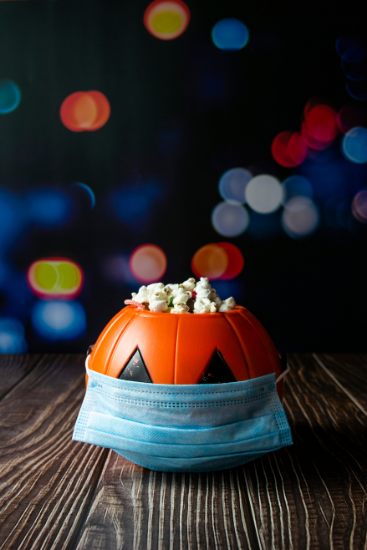Rosh Hashanah, Yom Kippur, Halloween, Día de Los Muertos, Navratri, Diwali, and Thanksgiving will likely need to be different this fall to prevent the spread of the virus that causes COVID-19. Avoid activities that are higher risk for spread. Consider fun alternatives that pose lower risk of spreading the virus that causes COVID-19.
Halloween
Many traditional Halloween activities can be high-risk for spreading viruses. There are several safer, alternative ways to participate in Halloween. If you may have COVID-19 or you may have been exposed to someone with COVID-19, you should not participate in in-person Halloween festivities and should not give out candy to trick-or-treaters.
Lower risk activities
These lower risk activities can be safe alternatives:
- Carving or decorating pumpkins with members of your household and displaying them
- Carving or decorating pumpkins outside, at a safe distance, with neighbors or friends
- Decorating your house, apartment, or living space
- Doing a Halloween scavenger hunt where children are given lists of Halloween-themed things to look for while they walk outdoors from house to house admiring Halloween decorations at a distance
- Having a virtual Halloween costume contest
- Having a Halloween movie night with people you live with
- Having a scavenger hunt-style trick-or-treat search with your household members in or around your home rather than going house to house
Moderate risk activities
- Participating in one-way trick-or-treating where individually wrapped goodie bags are lined up for families to grab and go while continuing to social distance (such as at the end of a driveway or at the edge of a yard)
- If you are preparing goodie bags, wash your hands with soap and water for at least 20 second before and after preparing the bags.
- Having a small group, outdoor, open-air costume parade where people are distanced more than 6 feet apart
- Attending a costume party held outdoors where protective masks are used and people can remain more than 6 feet apart
- A costume mask (such as for Halloween) is not a substitute for a cloth mask. A costume mask should not be used unless it is made of two or more layers of breathable fabric that covers the mouth and nose and doesn’t leave gaps around the face.
- Do not wear a costume mask over a protective cloth mask because it can be dangerous if the costume mask makes it hard to breathe. Instead, consider using a Halloween-themed cloth mask.
- Going to an open-air, one-way, walk-through haunted forest where appropriate mask use is enforced, and people can remain more than 6 feet apart
- If screaming will likely occur, greater distancing is advised. The greater the distance, the lower the risk of spreading a respiratory virus.
- Visiting pumpkin patches or orchards where people use hand sanitizer before touching pumpkins or picking apples, wearing masks is encouraged or enforced, and people are able to maintain social distancing
- Having an outdoor Halloween movie night with local family friends with people spaced at least 6 feet apart
- If screaming will likely occur, greater distancing is advised. The greater the distance, the lower the risk of spreading a respiratory virus.
Higher risk activities
Avoid these higher risk activities to help prevent the spread of the virus that causes COVID-19:
- Participating in traditional trick-or-treating where treats are handed to children who go door to door
- Having trunk-or-treat where treats are handed out from trunks of cars lined up in large parking lots
- Attending crowded costume parties held indoors
- Going to an indoor haunted house where people may be crowded together and screaming
- Going on hayrides or tractor rides with people who are not in your household
- Using alcohol or drugs, which can cloud judgement and increase risky behaviors
- Traveling to a rural fall festival that is not in your community if you live in an area with community spread of COVID-19
Día de los Muertos
Many traditional activities can put you at higher risk for exposure to COVID-19. There are several safer, alternative ways to celebrate Día de los Muertos. If you may have COVID-19 or you may have been exposed to someone with COVID-19, you should not participate in in-person Día de los Muertos festivities.
Lower risk activities
These lower risk activities can be safe alternatives:
- Preparing traditional family recipes for family and neighbors, especially those at higher risk of severe illness from COVID-19, and delivering them in a way that doesn’t involve contact with others
- Playing music in your home that your deceased loved ones enjoyed
- Making and decorating masks or making an altar for the deceased
- Setting out pillows and blankets in your home for the deceased
- Joining a virtual get-together celebration
Moderate risk activities
- Having a small group outdoor, open-air parade where people are distanced more than 6 feet apart
- Visiting and decorating graves of loved ones with household members only and keeping more than 6 feet away from others who may be in the area
- Hosting or attending a small dinner with local family and friends outdoors where people are distanced more than 6 feet apart
Higher risk activities
Avoid these higher risk activities to help prevent the spread of the virus that causes COVID-19:
- Attending large indoor celebrations with singing or chanting
- Participating in crowded indoor gatherings or events
- Having a large dinner party with people from different households coming from different geographic locations
- Using alcohol or drugs, which can cloud judgment and increase risky behaviors


